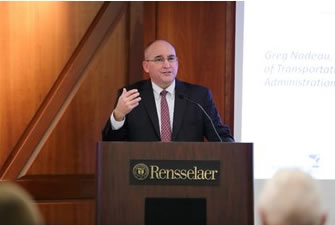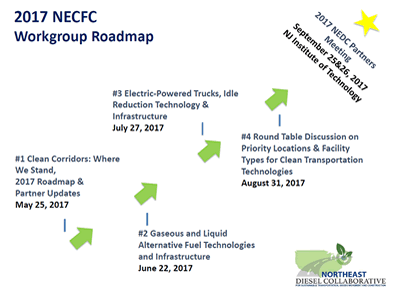Freight
On this page:
- Clean Corridors Meeting
- Clean Air Northeast Clean Freight Corridors Workgroup
- Federal Regulations
- State and Local Regulations
- FHWA Talking Freight Seminar Series
- Related Resources
- Smartway Transport Partnership
Clean Corridors Meeting

Dear Partners,
On behalf of the Meeting Hosts, thank you for joining us at RPI in Troy, New York for the first-ever Clean Corridors Meeting on November 3 & 4. Over 160 participants from the Northeast and beyond came together to discuss opportunities to collaborate on developing clean, sustainable freight and passenger corridors. We had great representation across states, agencies, disciplines, and sectors. Panelists provided succinct and stimulating presentations on key perspectives & issues. Participants rolled up their sleeves and debated openly on how to make progress toward our common vision of providing the multi-faceted fueling, charging and layover infrastructure needed to reduce emissions, enhance energy security, and stimulate the adoption of clean vehicle technologies. Throughout the meeting, it was clear that partners want to continue this collaboration into 2017 and beyond.
We are finalizing the meeting notes, presentations, and photos and will make them available to you over the next two weeks. The Cadmus Group and Atlas Policy team will soon provide tools to support state Dots' efforts to plan and implement clean corridors. We will offer all meeting participants and stakeholders a webinar in December to review lessons learned and discuss next steps to move this initiative forward.
View agenda from the Clean Corridors Meeting here (pdf) .
- Promoting Partnerships for Clean Freight Corridors
- Scott Perry, Chief Technology & Procurement Officer, Global Fleet Management
Solutions, Ryder System, Inc. (pdf) - Jennifer Ceponis, Clean Cities Coordinator, Capital District Clean Cities and Senior
Transportation Planner, Capital District Transportation Committee (pdf) - Michael Scarpino, Transportation Project Engineer, U.S. DOT-Volpe National
Transportation Systems Center (pdf)
- Scott Perry, Chief Technology & Procurement Officer, Global Fleet Management
- Moderated Panel Discussion #1: Current State of Clean Freight Corridor Planning
- Diane Turchetta, Transportation Specialist, U.S. DOT Federal Highway
Administration (pdf)(2.4 MB) - MaryGrace Parker, Program Coordinator, Freight Mobility, Security and Safety, I-95
Corridor Coalition (pdf) - Gina Campoli, Environmental Policy Manager, Vermont Agency of Transportation (pdf)
- Gerry Bogacz, Planning Director, New York Metropolitan Transportation Council (pdf)
- Barry Carr, Clean Cities Coordinator, Clean Communities of Central New York and
Director of Business Development, Landi Renzo, USA (pdf)
- Diane Turchetta, Transportation Specialist, U.S. DOT Federal Highway
- Moderated Panel Discussion #2: Market Drivers for Clean Freight Corridor Technologies and Fuels
- Bill Van Amburg: Overview (pdf)
- Kendra Hems, Executive Director, Trucking Association of New York (pdf)
- Rick Cameron, Managing Director of Planning and Environmental Affairs, Port of Long
Beach (pdf) - Erin Russell-Story, Project Manager, National Energy Technology Laboratory, and
Northeast Regional Manager, U.S. Department of Energy Clean Cities Program (pdf)
- Luncheon with Keynote Address: Future of Zero-Emission Freight Movement
- Moderated Panel Discussion #3: “Connecting the DOTs” to Create Clean Corridors & Sustainable Freight Networks
- Bethann Rooney, Assistant Director, Port Department, The Port Authority of New York
and New Jersey (pdf) - Wendy Ferguson, Talladega Project Manager, Virginia Transportation Corp. (pdf)
- Cara Wang, Assistant Professor, Department of Civil and Environmental Engineering,
Rensselaer Polytechnic Institute (pdf) - Chuck Feinberg, Clean Cities Coordinator, New Jersey Clean Cities and Partner and
Senior Consultant, Greener by Design, LLC. (pdf)
- Bethann Rooney, Assistant Director, Port Department, The Port Authority of New York
- Moderated Panel Discussion #4: Vision to Reality – Planning and Funding Clean Freight Corridors
- Mike Moltzen, Deputy Director, Transportation and Climate Division, Office of
Transportation and Air Quality, U.S. Environmental Protection Agency (pdf) - Patrick Bolton, Senior Project Manager, New York State Energy Research and
Development Authority (pdf) - Michael Franchini, Executive Director, Capital District Transportation Committee (pdf)
- Steve Russell, Alternative Transportation Program Coordinator and Clean Cities Co-
Coordinator, Commonwealth of Massachusetts (pdf) - Art James, Project Director, Oregon Department of Transportation (pdf)
- Mike Moltzen, Deputy Director, Transportation and Climate Division, Office of

Special Thank You to Our Supporting Partners
Platinum

Gold

Silver

Bronze

Clean Air Northeast Clean Freight Corridors Workgroup
The Clean Freight Corridors Workgroup promotes effective coordination across Northeastern states to plan for and develop clean freight corridors to advance high-efficiency, low-emission alternative transportation technologies across all modes.
2018 Clean Freight Corridors Workgroup Webinar: Northeast Opportunities for Alternative Fuel Corridors
On December 11th, the NEDC hosted a webinar highlighting opportunities in helping to grow a network of "alternative" (natural gas, propane, electric, fuel cell, hydrogen, etc) fueling stations for trucks and other medium/heavy -duty vehicles in the Northeast. The presentations and recorded audio of the webinar can be found below.

- Overview of program and nomination process (Mike Scarpino filling in for Diane Turchetta, FHWA) (pdf)
- Northeast corridors: stations, gaps, and potential (Mike Scarpino & Stephen Costa, DOT Volpe Center) (pdf)
- Demonstration of station locator and corridor view tools for NE states (Johanna Levene, NREL) (pdf)
- Alternative Fuels Convenings Update (Oana Leahu-Aluas, Cadmus Group) (pdf)
- Webinar Audio Recording
Take a look at the 2017 Clean Freight Corridor Roadmap! (pdf)

2017 Clean Freight Corridors Workgroup Webinar Series
Clean Corridors #1: Where We Stand, 2017 Roadmap and Partner Updates (5/25/2017)
Clean Corridors #2: Gaseous and Liquid Alternative Fuel Technologies and Infrastructure (6/22/2017)
- Webinar Video
- Presentation: Gaseous and Liquid Alternative Fuel Technologies and Infrastructure (pdf)
Clean Corridors #3: Electric-Powered Trucks, Idle-Reduction Technology and Infrastructure (7/27/2017)
- Webinar Video
- Presentation: Electric-Powered Trucks, Idle-Reduction Technology and Infrastructure (pdf)
Clean Corridors #4: Roundtable Discussion on Priority Locations and Facility Types for Clean Freight Technologies (8/31/2017)
Check out the 2016 Clean Freight Corridor Roadmap here! (pdf)

Clean Freight Corridors Workgroup Charter (pdf)
2016 Clean Freight Corridors Workgroup Webinar Series
Webinar 1: Workgroup Kickoff – Importance of Clean Freight Corridor Coordination (2/18/2016)
Webinar 2: Funding Clean Corridors (3/29/2016)
- Webinar Video
- Funding Clean Corridors Presentation (pdf)
- U.S. DOT FASTLANE and TIGER Presentation (pdf)
- Examples of DERA-funded Freight Projects (pdf)
Webinar 3: Regional Freight Flows (4/28/2016)
- Webinar Video
- FHWA: National & Regional Freight Flows (pdf)
- I-95 Corridor Coalition: Regional Freight & Performance Measures (pdf)
Webinar 4: Defining Clean Corridors (5/26/2016)
Webinar 5: Designating Clean Corridors (6/23/2016)
Webinar 6: Preparing Applications for Corridor Designation (7/28/2016)
- Webinar Video
- Preparing Applications Presentation (pdf)
- Northeast Clean Freight Corridors for Clean Cities (pdf)
Webinar 7: Meeting Hosts Discuss Goals for Nov. 3 & 4 - 2016 Clean Corridors Meeting (9/29/2016)
- Webinar Video
- Meeting Hosts Discuss Goals for Nov. 3 & 4 - 2016 Clean Corridors Meeting Presentation (pdf)
Webinar 8: U.S. DOE Clean Cities Tasks for Clean Corridors Meeting (Mid-October, 2016)
Clean Freight Corridors Workshop
November 2-4, 2016
Rensselaer Polytechnic Institute (RPI), Troy, NY
Federal Regulations
Regulations for Smog, Soot, and Other Air Pollution from Commercial Trucks & Buses
Clean Diesel Trucks and Buses Rule: The Clean Diesel Trucks and Buses Rule sets more stringent emissions standards for on-road diesel vehicles beginning with those manufactured in 2007. The Rule will be fully implemented by 2010. The rules require clean diesel fuel with a sulfur content capped at 15 parts per million and the use of advanced emission control technology. Exhaust emissions from these vehicles will decrease by more than 90 percent. While cleaner fuel will reduce emissions from all diesel vehicles, the new emission standards only affect newly manufactured on-road diesel vehicles, so the full benefits of these regulations will not be realized for years to come.
Control of Air Pollution from New Motor Vehicles: Heavy Duty Engine and Vehicle Standards: EPA adopted this rule in December 2022 which sets stronger emissions standards to further reduce air pollution from nitrogen-oxide (NOx) emissions from heavy-duty vehicles and engines starting in model year 2027. The rule sets new, more stringent emissions standards that cover a wider range of heavy-duty engine operating conditions compared to today’s standards, and it requires these more stringent emissions standards to be met for a longer period of time of when these engines operate on the road.
Emissions Standards for Locomotives: In 2008, EPA finalized a new set of more stringent emission limits for locomotives, to be phased in over the next decade, which will result in locomotive engines that are 90% cleaner than today. This new rule also requires remanufactured locomotive engines to meet more stringent emissions standards than they were required to meet at the time of original manufacture.
EPA's Locomotive Emissions Rule (Abby Swaine, March, 2014) (pdf)
State and Local Regulations
Six of the eight Northeast states have anti-idling regulations:
EPA NE conducts compliance assistance to encourage fleet and facility operators to comply with New England states' idling limits.
The American Transportation Research Institute publishes a compendium of idling regulations by state and updates it regularly.
FHWA Talking Freight Seminar Series
The U.S. Department of Transportation Federal Highway Administration hosts monthly net-conference seminars to provide a convenient and no-cost way for transportation practitioners to broaden their freight knowledge base and develop new skills to help them do their jobs better. Visit https://www.fhwa.dot.gov/planning/freight_planning/talking_freight/index.cfm to register for upcoming sessions and see/hear recordings of previous seminars.
Related Resources
Best Practices Guidebook for Greenhouse Gas Reductions in Freight Transportation
Freight transportation accounts for approximately 9% of total greenhouse gas (GHG) emissions in the United States. This report for the US Department of Transportation surveys 59 potential best practices for reducing energy use and GHG emissions in freight transportation.
Scoping Study to Evaluate Locomotive Emissions Operating in New Haven, Connecticut and Potential Control Options (NESCAUM, June 2006)
This report presents a preliminary inventory of locomotive emissions and evaluates potential control options to reduce locomotive pollution in New Haven and Fairfield, two densely populated counties in which most of Connecticut’s rail activity takes place.
Smartway Transport Partnership
The SmartWay Transport Partnership is a voluntary collaboration between US EPA and the freight industry designed to conserve fuel while significantly reducing greenhouse gases and other air pollutants. Companies that provide or hire freight delivery and logistics services can become SmartWay Transport partners. EPA helps partners calculate their current environmental performance, set improvement goals, understand fuel-saving strategies and technologies, calculate cost savings, and win industry and public recognition. SmartWay also verifies the performance of fuel-saving technologies, certifies trucks and trailers with energy-saving features, and offers a variety of financing opportunities.
Currently over 2000 shippers, carriers, logistics providers, and affiliates participate in the Partnership, including hundreds in Canada. SmartWay is quickly expanding its international reach and developing new tools to help shippers analyze their carbon reduction options more accurately within and across all modes in their "supply chain" (truck, rail, port drayage, marine, etc.).
EPA Regions 1 and 2 are active in SmartWay, both recruiting and supporting partners. New in 2009 are cooperative agreements, one in both Regions 1 and 2, with Cascade Sierra Solutions to provide rebates for truck & trailer upgrades.
